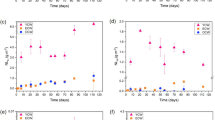Abstract
Titanates and titanate- or titanosilicate-based ceramics are being considered as possible nuclear waste hosts in several national waste management programmes1–4, largely because of their excellent resistance to leaching. The leach resistance of titanates has been attributed to the formation of largely insoluble, titanium dioxide rich layers, formed at the surface by selective leaching of univalent and divalent cations5. We have examined the leaching of the titanosilicate sphene (CaTiSiO5) in the form of natural samples, sintered ceramics and glasses of stoichiometric sphene composition. We report ESCA (electron spin for chemical analysis) or XPS (X-ray photoelectron spectroscopy) and SIMS (secondary ion mass spectrometry) studies of leached CaTiSiO5 glasses, demonstrating the nature of leached surface layers on a titanosilicate. These results also illustrate the parallels between the leaching of sphene glasses in deionized water and the leaching mechanism proposed for titanates5.
This is a preview of subscription content, access via your institution
Access options
Subscribe to this journal
Receive 51 print issues and online access
$199.00 per year
only $3.90 per issue
Buy this article
- Purchase on Springer Link
- Instant access to full article PDF
Prices may be subject to local taxes which are calculated during checkout
Similar content being viewed by others
References
Ringwood, A. E., Kesson, S. E., Ware, N. G., Hibberson, W. O. & Major, A. Geochem. J. 13, 141 (1979).
Dosch, R. G., Lynch, A. W., Headley, T. J. & Hlava, P. F. in Scientific Basis for Nuclear Waste Management Vol. 3 (ed. Moore, J. G.) 123 (Plenum Press, New York, 1981).
Forberg, S., Westermark, T. & Falth, L. Scientific Basis for Nuclear Waste Management Vol. 3 (ed. Moore, J. G.) 227 (Plenum Press, New York, 1981).
Hayward, P. J. & Cecchetto, E. V. in Scientific Basis for Nuclear Waste Management Vol. 6 (ed. Topp, S. V.) 91 (Elsevier North-Holland, New York, 1982).
Ringwood, A. E. et al. Nuclear and Chemical Waste Management 2, 287–305 (1981).
Bancroft, G. M., Gupta, R. P., Hardin, A. H. & Ternan, M. Analyt. Chem., 51, 2102 (1979).
Barkatt, A., Simmons, J. H. & Macedo, P. B. Phys. Chem. of Glasses 22, 73 (1981).
Hench, L. L. & Clark, D. E. J. non-crystalline Solids 28, 83 (1978).
Altenhein, F. K., Lutze, W. & Malow, G. Scientific Basis for Nuclear Waste Management Vol. 3 (ed. Moore, J. G.) 363 (Plenum Press, New York, 1981).
Metson, J. B., Bancroft, G. M., Kanetkar, S. M., Nesbitt, H. W., Fyfe, W. S. & Hayward, P. J. in Scientific Basis for Nuclear Waste Management (ed. Lutze, W.) (Elsevier North-Holland, in the press).
Author information
Authors and Affiliations
Rights and permissions
About this article
Cite this article
Bancroft, G., Metson, J., Kanetkar, S. et al. Surface studies on a leached sphene glass. Nature 299, 708–710 (1982). https://doi.org/10.1038/299708a0
Received:
Accepted:
Issue Date:
DOI: https://doi.org/10.1038/299708a0
This article is cited by
-
Potassium Niobate Nanolamina: A Promising Adsorbent for Entrapment of Radioactive Cations from Water
Scientific Reports (2014)
Comments
By submitting a comment you agree to abide by our Terms and Community Guidelines. If you find something abusive or that does not comply with our terms or guidelines please flag it as inappropriate.



